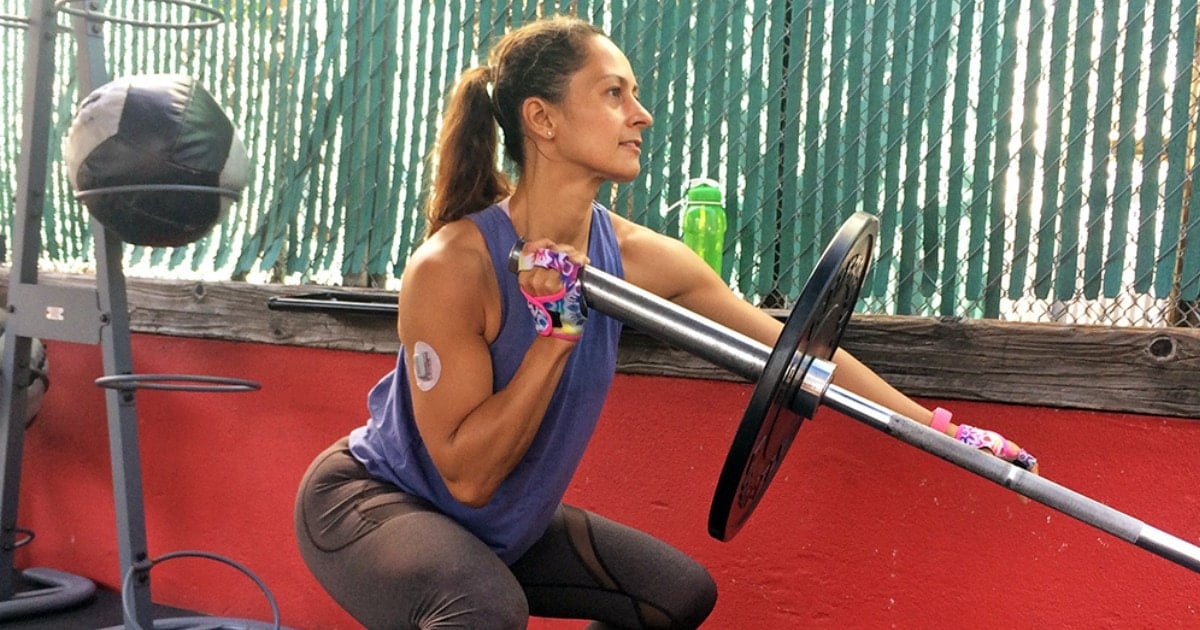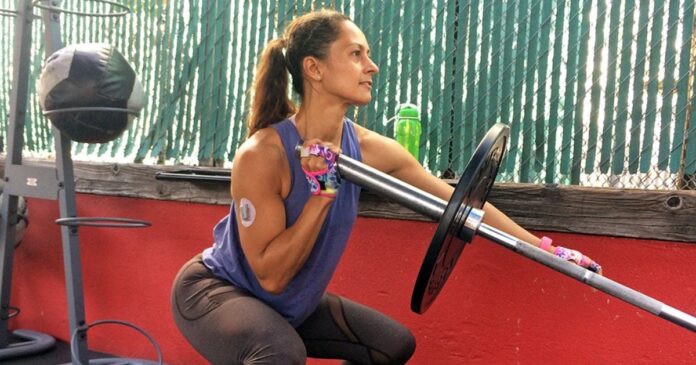Exercising with sort 1 diabetes isn’t easy — however it’s doable if you happen to study the important science of juggling insulin, timing, vitamin, and cardio vs. anaerobic train.
Right here’s a more in-depth have a look at exercising safely with sort 1 diabetes with excerpts from my guide “Train with Sort 1 Diabetes”.
How a lot train do you want?
Common train can have an amazing impression in your capability to handle your weight, your insulin sensitivity, and your blood sugars. The extra constant you might be with every day train, the extra you’ll reap these advantages.
The U.S. Facilities for Illness Management & Prevention (CDC) recommends no less than 150 minutes of moderate-intensity bodily exercise per week.
This breaks right down to about 20-25 minutes per day. Somewhat goes a great distance! (And don’t underestimate the worth of an everyday stroll!)
In case you are introducing common train to your every day routine, make sure you plan along with your healthcare group alter your insulin doses — you may see a direct and gradual improve in your sensitivity to insulin. This implies you’ll want to scale back your insulin doses (basal and/or bolus) to stop hypoglycemia.
Managing insulin-on-board
Exercising safely begins with managing your insulin-on-board (IOB) and the timing of your exercise. IOB refers to how a lot insulin is at the moment lively in your bloodstream.
When you could have an excessive amount of IOB throughout the hours of your exercise, your danger of low blood sugar is extraordinarily doubtless.
There are three frequent approaches to managing IOB to stop low blood sugar throughout train:
- Exercising a number of hours after consuming or taking insulin for a meal
- Exercising proper after consuming however lowering your meal bolus and/or basal insulin
- Exercising whenever you really feel prefer it and consuming plenty of sweet or juice to get via it
Should you’re getting an excessive amount of or too little basal/background insulin through injected long-acting insulin or pumped rapid-acting insulin, fasted train merely ain’t gonna go as deliberate. Studying fine-tune and alter your background dose(s) is a should.
Remember that changes to your basal/background insulin doses ought to be completed in very small tweaks — a change of not more than 1 or 2 items whole at a time for insulin-sensitive folks.
For these on bigger doses, your physician might advocate bigger changes of three+ items at a time. Watch the impression for a few days, then alter once more if wanted.
Listed below are the fundamentals to think about when fine-tuning background insulin doses for fasted train:
Low blood sugars throughout fasted train doubtless imply: You’re getting an excessive amount of basal/background insulin whether or not it’s cardio or anaerobic.
- Should you’re on injected long-acting insulin: Typically a tiny adjustment could make an enormous distinction. A discount of simply 1 or 2 items can handle these lows, however don’t be shocked if meaning you want a bit extra for meals. Many individuals are on considerably an excessive amount of basal insulin which suggests the introduction of any bodily exercise sends their blood sugars repeatedly crashing. Get these doses down!
- In case you are on an insulin pump: Most individuals discover they should scale back basal charges by anyplace from 25 to 75 % beginning 1 hour earlier than cardio train. It actually requires a substantial amount of trial and error. Most individuals even have already adjusted their basal charges to account for spikes within the early morning as a result of daybreak phenomenon, so that’s much less of an element to think about if you happen to’re pumping.
Excessive blood sugars throughout fasted train doubtless imply: You’re not getting sufficient insulin both through basal/background OR you want a small bolus to handle spikes brought on by anaerobic train or daybreak phenomenon.
Anaerobic train raises blood sugar: Some folks discover they want a small bolus earlier than, throughout, or after intense power coaching or different anaerobic train. That is regular! Experiment rigorously and take good notes.
The tiniest changes could make a giant distinction! Simply 1 or 2 items added or subtracted out of your whole basal/background insulin dose(s) could make it that a lot simpler to take pleasure in train safely.
Why “fasted” train reduces your danger of lows
Should you can time your exercises for when you could have the least quantity of rapid-acting insulin in your system (your IOB), you possibly can massively scale back your danger of low blood sugar.
Within the context of sort 1 diabetes, the phrase “fasted” train refers to exercising no less than a number of hours after the final time you ate and took mealtime insulin. By exercising earlier than you eat a meal, you might be exercising whenever you don’t have a big bolus of rapid-acting insulin in your bloodstream. Most rapid-acting insulin is totally lively in your system for roughly 4 hours after dosing.
Fasted train is not meant for endurance sports activities — hours of exercising — as a result of your physique is inevitably going to want re-fueling finally for lengthy athletic occasions.
“Fasted” train nonetheless requires basal/background insulin — even when it’s a considerably decreased dose through your insulin pump. Should you’re on long-acting injected basal insulin, you might must make gradual reductions to the every day dose whenever you add train to your routine.
As folks dwelling with sort 1 diabetes, we want some lively insulin current always so as to keep alive. With out sufficient basal/background insulin at any given time, an individual with sort 1 diabetes can rapidly go into diabetic ketoacidosis — which is extraordinarily harmful and could be deadly.
“Fasted” train just isn’t equal always of the day. Pre-breakfast exercises are inclined to see much less change in blood glucose as a result of ranges of hormones like cortisol are nonetheless excessive from in a single day. Pre-lunch exercises whenever you had insulin at breakfast are a totally completely different animal.
Aerobic and anaerobic train
You will need to study the distinction between cardio (cardio) train vs. anaerobic train to higher predict the impression it should have in your blood sugar and insulin wants.
Cardio train is an exercise you possibly can carry out for an prolonged time period with out stopping. Throughout cardio train, your coronary heart price continues to be low sufficient that your physique is ready to cycle oxygen to your fats cells to burn for gasoline. Or, if there’s loads of IOB, your sources of gasoline will doubtless be glucagon and the glucose in your bloodstream.
Examples of cardio train: strolling, jogging, kayaking, rollerblading, energy yoga, skating, vacuuming, gardening, biking, dancing, mountaineering, chasing children, and many others.
Cardio train will increase how rapidly insulin picks up glucose and carries it to cells — as a result of your cells are demanding extra glucose to maintain your physique shifting and performing! In an individual with T1D, this could trigger dramatic low blood sugar.
You’ll be able to considerably scale back how a lot glucose cardio train makes use of for gasoline by rigorously timing your exercises to scale back IOB.
Anaerobic train is an exercise that’s normally carried out at an depth you possibly can solely maintain for a couple of minutes at most. Then you definitely take a break — for anyplace from 30 seconds to 2 minutes — then you definately carry out one other spherical, and so forth.
Examples of anaerobic train: lifting weights, sprinting, CrossFit, HIIT exercises, spinning intervals, and many others.
Your coronary heart price throughout anaerobic train is so excessive that your physique should use glucose for gasoline by changing saved glucose (glycogen) in your muscle tissue and lactic acid to glucose. That glucose is then cycled again to your muscle groups for gasoline with slightly assist from insulin.
For some kinds of anaerobic train, the insulin out of your basal price/dose may be lots. For extra intense anaerobic train, you might want extra insulin to handle that additional glucose.
After anaerobic train, your liver may launch saved glucose out of your liver to assist replenish the glucose shops in your muscle groups — with slightly assist from insulin. In an individual with T1D, this could trigger sudden spikes in blood sugar.
Combined exercises with cardio & anaerobic train: Once you mix each kinds of train into one exercise, you’ll wish to take into account the impression of each.
For instance, if you happen to carry weights for half-hour and then jog for half-hour, the rise in your blood sugar from lifting weights may very well be offset by the jogging that will decrease your blood sugar.
Should you carry out half-hour of cardio first, you possibly can anticipate your blood sugar to development downwards (even with little-to-no IOB), then anticipate the half-hour of weightlifting to convey it again up.
Like some other sort of exercise, mixing cardio and anaerobic merely requires some cautious preparation, consistency as you research what occurs, and good notes!
Once you shouldn’t exercise
There are a couple of conditions through which you must not train as an individual with T1D.
In case your blood sugar is over 250 mg/dL: Exercising with blood sugars over 250 mg/dL can put you liable to growing ketones — significantly if you happen to wouldn’t have sufficient IOB. Whereas train with a considerate dose of correction insulin might assist convey your blood sugar down, it ought to be completed with consideration of ketones. In case your blood sugar is over 300 mg/dL earlier than exercising, testing for ketones is a should!
If you have already got ketones: Exercising with ketones may be very harmful and might additional the manufacturing of ketones, rising your danger of diabetic ketoacidosis (DKA). Contact your healthcare group for help or go to the closest emergency division if you happen to exhibit indicators of DKA.
Be ready for lows and take good notes
It doesn’t matter what sort of train you’re doing, you must at all times carry fast-acting carbohydrates with you, like glucose tabs, juice, jelly beans, or gummies.
Lastly, take good notes!
Should you’re experiencing low blood sugar after each Zumba class, that tells you loud and clear that you’ve an excessive amount of insulin on board earlier than and through class.
In case your blood sugar is constantly spiking an hour after your weightlifting exercise that tells you loud and clear that you just most likely want a post-workout bolus of rapid-acting insulin.
Take good notes. Whereas blood sugar fluctuations throughout train could be very irritating, they’re not illogical. Take a deep breath and hold experimenting!


